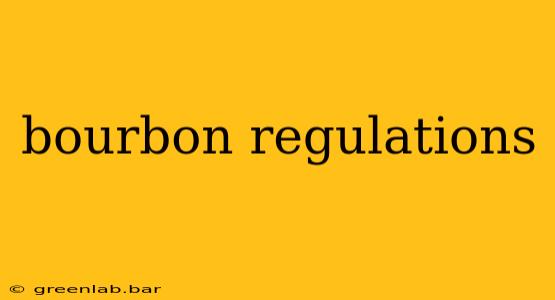Bourbon. The very word conjures images of oak barrels, smoky aromas, and a rich history deeply intertwined with American culture. But what exactly is bourbon, and what regulations govern its production? This comprehensive guide delves into the intricate rules and regulations that define this iconic spirit, ensuring its quality and authenticity. Understanding these regulations is key to appreciating the craftsmanship and dedication behind every bottle.
Defining Bourbon: The Legalities of a Legacy
The legal definition of bourbon whiskey is surprisingly specific, dictated by the United States Code of Federal Regulations (CFR). These regulations aren't just about taste; they define the very essence of what constitutes bourbon, protecting both consumers and producers.
Key Regulatory Requirements:
-
Grain Bill: At least 51% corn must be used in the mash bill (the mixture of grains used in fermentation). This is the cornerstone of bourbon's characteristic sweetness. Other grains, such as rye, wheat, and barley, can make up the remaining portion, contributing to the unique flavor profiles of different bourbons.
-
New Charred Oak Barrels: Bourbon must be aged in new, charred oak barrels. This process is crucial for imparting color, flavor, and aroma to the spirit. Re-using barrels is strictly forbidden for bourbon production. The charring itself influences the flavor profile; a heavier char yields a bolder, spicier bourbon, while a lighter char results in a smoother, more nuanced spirit.
-
Distillation Proof: The spirit must be distilled to no more than 160 proof (80% alcohol by volume).
-
Entry Proof: The spirit must enter the barrel at no more than 125 proof (62.5% alcohol by volume).
-
Bottling Proof: Bourbon can be bottled at varying proofs, but the minimum is 80 proof (40% alcohol by volume).
-
Aging: Bourbon must be aged in new, charred oak barrels for a minimum of two years. Many bourbons age significantly longer, resulting in more complex and nuanced flavors. The longer the aging process, the more interaction occurs between the spirit and the wood, impacting the final taste.
-
Production Location: While the ingredients can be sourced from anywhere, the fermentation, distillation, and aging must all take place within the United States. This is a key component of bourbon's designation as an "American" whiskey.
Beyond the Basics: Understanding the Nuances of Bourbon Regulations
The regulations extend beyond the basic requirements, encompassing aspects such as labeling and geographic indications. These details further ensure quality and prevent misrepresentation.
Labeling Requirements:
The labeling of bourbon is strictly regulated, ensuring consumers receive accurate and transparent information. This includes clearly stating the age, proof, and any additional information relevant to the product. Misleading labels are strictly prohibited.
Straight Bourbon and Other Classifications:
The term "straight bourbon" signifies that the bourbon meets all the aforementioned requirements, without any added flavors or coloring agents. Other classifications, such as "bourbon" or "small batch bourbon," have their own specific rules, adding layers of complexity to the regulatory framework.
The Importance of Bourbon Regulations
These stringent regulations serve a critical purpose: they protect both the consumer and the integrity of the bourbon industry. They guarantee the quality and authenticity of the product, allowing consumers to trust the label and enjoy a spirit that meets a high standard of excellence. Moreover, these regulations safeguard the unique identity of bourbon, preserving its place as a prized American spirit.
Conclusion: A Toast to Regulation
The comprehensive regulations surrounding bourbon production demonstrate the commitment to maintaining the highest standards of quality and authenticity. These rules, while intricate, are the foundation upon which this iconic American spirit is built, guaranteeing that every sip reflects generations of tradition and expertise. By understanding these regulations, we can better appreciate the dedication and craftsmanship behind each bottle of bourbon.

